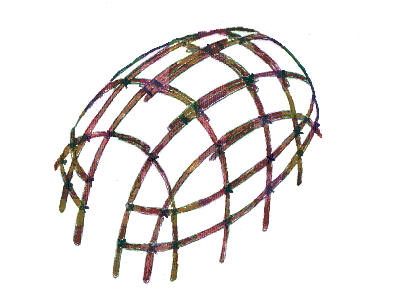


Almost everyone is familiar with the Indian teepee of Hollywood westerns, but you may be wondering about the wigwam that Chogan and Konti called home. Just as our homes today come in a variety of sizes and shapes, Native American lodges took many forms depending on the climate and the availability of building materials. Chogan and Konti lived in the northern-most section of America where the winters were cold and harsh and snowfall heavy. The dome-shaped wigwam was perfect for their needs. Fortunately, they had access to a variety of wood and did not need to relocate as frequently and their counterparts on the western plains who had to follow the buffalo herds.
Wigwam Frame

Chogan and his family needed a structure that could support the heavy snow and also provide shelter from the harsh northern winters. The dome shape of the wigwam has natural strength, and any snow that accumulated on the wigwam roof provided additional insulation from the cold. Grandfather constructed his wigwam frames by inserting one end of a long pole in the ground and then bending the pole until it formed an arch with a similar pole. He lashed the poles together using the inner bark of a basswood tree. Then he added a series of tapering arches on each side of the large arch to form the wigwam’s shape. He placed his arches about two feet apart, all pointing in the north-south direction. Next Grandfather added more arches, this time in an east-west direction, perpendicular to the previous arches. Lastly, he lashed poles to the sides of the frame for extra strength. When completed the frame looked like the diagram at the left.
Outer Covering
Native Americans used a variety of materials to cover their wigwam frames. Grandfather preferred birch bark, because it was so abundant along the Lake Superior shore, but he covered the sides of his wigwam with mats made from woven cattail reeds. Elm bark was another favorite among some Native Americans because it could be obtained in large sheets and quickly covered the wigwam frame. They tied the bark to the frame with strips of basswood bark. An elm bark-covered wigwam would look similar to the wigwam at the right. Note the poles around the outside of the wigwam. High winds often catch the bark’s flat surfaces, ripping them away from the frame if not securely lashed down. Sometimes Native Americans leaned poles against the wigwam to hold the bark in place.
Wigwam Door
Native Americans made sure their wigwam entrances pointed toward the east. The winds in the Great Lakes area normally come from the west, and they did not wish to have snow blowing through the entrance. The wigwam at the left is on display at the Chippewa Nature Center near Midland, Michigan. For the convenience of visitors, the door is larger than the door Grandfather would have made. Grandfather’s door would have been covered with deer or moose skin, and visitors to his wigwam would have to stoop to enter.
Sleeping Bench
The ground is not only hard, but it is cold and rapidly conducts heat away from the body. Chogan and his family, therefore, slept on benches similar to the benches in the picture to the right. The benches could be quite cozy when covered with animal skins. Maybe that is why Chogan found it so difficult getting up in the morning. When not sleeping, they used the benches for sitting. Chogan and Konti stored their personal belongings under their benches.
Fire Pit
Even when sleeping on benches covered with animal skins, Chogan would have gotten mighty cold during those winter months if Mother or Grandfather didn’t kindle a small fire in the fire pit at the center of the wigwam. Because of the wigwam's small size, it didn’t take a very large fire to make the winter bearable. Note the fireguard between the door and the fire pit in the picture to the left. The fireguard prevented any draft from the doorway from blowing smoke around in the wigwam. The smoke should flow straight up and through the hole in the ceiling. This did not always happen, and most of the time Chogan and Konti smelled like smoked fish.